GREEN TEA
Types of Green Tea - There is quite a wide variety of green teas to choose from. With all the choices out there, let's take a look at some of the more common types that you may run into....
Sencha - 85% of Japan's tea harvest is in the form of sencha. This tea is grown in the full sun, and is harvested 3-4 times per year. The quality of the tea goes down as the year progresses, with the first harvest, known as Shincha (see below), condidered to be the best.
Shincha - Shincha means "New Tea", the term being derived from the fact that it comes from the buds of the first harvest of Sencha in late April to early May. Shincha is usually a higher quality tea, and in fact has the highest polyphenol content of all the green teas.
Gyokuro - One of the most expensive teas grown in Japan, this item is grown under 90% shade for two weeks before harvesting, and only the first flush is used. Contrary to popular opinion, gyokuro has slightly less polyphenols than a high grade of sencha (shincha), but does have a slightly higher amount of free amino acids, as well as theanine content. Due to it's lower tannin content, gyokuro has a mellower, sweeter, less astringent taste when compared with sencha.
Kabuescha - Somewhat of a cross between shincha and gyokuro, this item is grown under 40-50% shade for one to two weeks. A high quality tea, only the first flush is used for this product.
Matcha - Famous for it's use in the tea ceremony, matcha is grown in the same fashion as gyokuro. When processed, however, the leaves are dried but not rolled. Only the soft parts of the leaf are used, resulting in what is known as tencha. The tencha is then ground into a talcum-like powder and becomes matcha. The polyphenol content of matcha is about half that of sencha or gyokuro, however it has the highest concentration of free amino acids and theanine of all the green teas.
Ryokucha - Powdered sencha, similar to matcha except that is is ground from sun grown sencha instead of shade grown gyokuro.
Ujicha - Although most tea production in Japan occurs in Shizuoka, the small area south of Kyoto known as Uji produces some of the highest quality green teas available. You may often encounter various types of items with "Uji" tacked on to the front, and is often, but not always, the mark of a higher class of tea.
Bancha - Harvested from the last harvest, it is considered to be of a lesser quality than regular sencha. Nevertheless, it is quite tasty when iced.
Kukicha - Generally low grade, made from the stems sencha.
Kariganecha - Made from the stems of gyokuro instead of sencha. When blended with sencha, it is known as "Karigane Sencha", and gives a nice, sharp taste.
Hojicha - This is bancha that has been baked. Instead of having a green color, the heat treatment emparts a red color, giving it a unique taste. Since it is caffeine free, this item is often served in Japan to patients in hospitals or to children. Quite delicious iced.
Fukamushicha - Sencha that, during processing, is steamed for a longer period of time (90 seconds) in comparison to the normal 30 second steam time. Steaming time is usually dependant on the leaf used. Leaves grown at different elevations and under differing conditions will require different steaming times, as judged by an expert.
Genmaicha - Sencha mixed with brown puffed rice. Quite delicious.

DRINKING GREEN TEA MAY AID IN WEIGHT LOSS
Two studies were researched to propose that drinking green tea
might aid in weight loss. The first study compared the metabolic effect
of green tea, in extract, to that of a placebo. The second study,
researched by the University of Geneva, investigated the outcome of the
combination of caffeine and a compound called epigallocatechin (EGCG),
which is a catechin, found in green tea.
In the first study,
researchers found that green tea drinkers burned an additional 70
calories a day. It is believed that the difference is caused by
metabolism enhancing antioxidants, also known as catechins. These
metabolism-enhancing catechins are found in green tea. In the second
study, researchers discovered that the combination of caffeine and
epigallocatechin (EGCG) could enhance metabolic rate by 4%.
More
research is required.
![]()
GREEN TEA MAY PREVENT SUN-INDUCED SKIN DAMAGE
In a case study researched at Case Western Reserve University in Cleveland, OH, it was found that green tea extracts are also beneficial if they are applied to the skin. Today, an escalating amount of skin-care products are beginning to contain green tea extracts.
To obtain this benefit, at least 4 cups of green tea need to be drank a day. Note that weaker iced-tea is not effective in receiving this benefit.
We can think of green tea as a supplement for sunscreen, not as a substitute for it.
HEART ATTACK SURVIVAL RATES AND CONSUMPTION OF TEA
Researchers at Beth Israel Deaconess Medical Center in Boston, MA performed a study to demonstrate that tea consumption, both black and green tea can extend years of life after a heart attack.
In this study, 1,900 heart attack survival victims, including both men and women in their 60s, were asked tea consumption questions.
Among the 1,900 individuals who had suffered heart attacks, it was found that heavy tea drinkers who drank 19 or more cups a week reduced their risks of dying over the next 3-4 years by 44% compared to that of non-tea drinkers.
Moderate drinkers who drank less than 14 cups a week reduced their risks by 28% compared to non-tea drinkers.
TEA MAY STRENGTHEN BONES
In a study, executed by researchers from National Cheng Kung University Hospital in Tainan, Taiwan, it had been suggested that drinking tea might strengthen bones. Tea contains fluoride and flavanoids, both of which may enhance bone strength.
This study was based on 1,037 men and women, 30 and older, which were questioned about tea consumption habits and had bone-mineral density tests.
It was found that the benefits were most noticeable in people who drank at least 2 cups of tea a day for at least 6 years. The highest overall bone-mineral density test was found in people who had consumed tea habitually for more than 10 years; their bone mineral density test was 6.2% higher than in non-habitual tea drinkers. Habitual tea drinkers for 6-10 years had bone mineral density tests that were 2.3% higher than non-habitual tea drinkers. No significant differences between tea drinkers of 1-5 years and non-habitual tea drinkers were established.
DRINKING GREEN TEA REDUCES THE EFFECTS OF CIGARETTE SMOKING
In two different studies, one by scientists at the Academy of Preventive Medicine in Beijing, China and the other by James Klaunig at the Indiana University School of Medicine in Indianapolis, the effects of green tea on oxidative stress, brought on by the toxins of cigarette smoke, were investigated. Oxidative stress, an imbalance in the pro-oxidant/antioxidant status of a cell, appears to cause or participate in the development of certain diseases-notably cancer.
Researches found that when cigarette users drank an equivalent of six cups of green tea a day, their bodies suffered 40% to 50% less oxidative damage. This potentially lowers their risk of cancer, emphysema, heart disease and other illnesses. Oxidative damage was reduced to that of levels found in nonsmokers prior to drinking green tea. However, it is important to note that those who drink green tea and continue to smoke are still raising their risk of experiencing oxidative damage. Nonsmokers who were studied exhibited significant decreases in oxidative damage as well.
GREEN TEA MAY PREVENT ORAL CANCER
At a symposium in Washington DC, 1998, a team of Chinese scientists, Ning Li from the Institute of Nutrition and Food Hygiene, Zheng Sun from the Chinese Academy of Preventive Medicine and Junshi Chen from the Beijing Dental Hospital, revealed that drinking green tea improves pre-cancerous conditions of oral leukoplakia in patients and suggests it may have certain preventive effects in oral cancer.
The study involved 32 patients, 20 males and 12 females, 23-28 years of age with oral mucosa leukoplakia, a pre-cancerous lesion of oral cancer. During a six month period, patients drank three cups of green tea a day and applied a mixture of green tea and glycerin directly to the lesion.
As a result, 38% of the patients experienced a reduction in the size of a single lesion or in the total size of multiple lesion by 30% or more. 59% saw no changes at all. At the same time, the frequency and rate of formation of cancerous cells decreased significantly.
Although the sample size and the time of treatment of this study are limited, the results provide encouraging and direct evidence on the preventive effects of green tea on human cancer.
GREEN TEA MAY PREVENT RHEUMATOID ARTHRITIS
Medical researchers at Case Western Reserve University in Cleveland, published a study in April, 1999 reporting that drinking four or more cups of green tea a day may prevent rheumatoid arthritis and reduce the severity of it in those who are currently battling the disease.
The study was conducted on mice with collagen induced arthritis, which is similar to that of rheumatoid arthritis in humans. The mice that received green tea were less likely to develop arthritis than the mice who received plain drinking water. However, the mice that received green tea and yet still developed arthritis had less severe forms of arthritis.
It was concluded that the antioxidants present in green tea possess not only cancer-preventeing properties but also anti-inflammatory properties. Rheumatoid arthritis is an inflammatory disease that causes pain, swelling, stiffness, and loss of function in the joints. The antioxidants in green tea may prevent or reduce the severity of these symptoms.
Although further research is needed in this area, the study closely mimics the human disease of Rheumatoid arthritis and provides encouraging evidence on the preventive effects of green tea on Rheumatoid arthritis.
GREEN TEA AS CANCER PREVENTIVE
Continuing research on the beneficial properties of green tea to human health has produced several new findings. Most notable is a study by Japanese scientists of the Saitama Cancer Research Institute relating the delay of cancer onset with the consumption of green tea. The study shows that early stage breast cancer spreads less rapidly in women with a history of drinking five or more cups of green tea a day. As a result, there is a lower recurrence rate and a longer disease-free period.
With the evidence that green tea and EGCG, a catechin found only in green tea, are a natural and readily available inhibitor of TNF-, a gene expression which promotes the growth in cancer cells and in their surrounding tissue, it is possible for researchers to extend this idea to other various human diseases. Since EGCG has also been proven to kill cultured cancer cells without causing harm to surrounding healthy cells, green tea could be beneficial not only for cancer prevention but also in the therapy and prevention of other diseases.
STRONGEST OF ALL ANTIOXIDANTS FOUND IN GREEN TEA
In September, 1997 a study by Dr. Lester Mitscher, professor of medicinal chemistry at the University of Kansas concluded that green tea contains the strongest of any known form of antioxidants.
The study found that a cathechin in green tea, epigallocathechin gallate (EGCG), was more than 100 times as effective at neutralizing free radicals as vitamin C, and 25 times more powerful than vitamin E. Both are well known antioxidants. EGCG also topped other antioxidants, such as BHA, BHT, and Resveratol. Antioxidants are thought to prevent cellular damage that leads to certain diseases - especially cancer.
Mitscher indicated that green tea contained, by far, the highest concentrations of active EGCG. He also stated that the daily consumption of green tea needed for antioxidant effect has not been established, but pointed to previous studies in China and Japan, where people customarily drink four (or more) cups per day. It has not been determined whether one cup per day is sufficient.
FURTHER RESEARCH IS NEEDED. GREEN TEA CATECHIN COULD INHIBIT TUMOR GROWTH
In June of this year, Dr. Jerzy Jankun and associates from the Medical College of Ohio published a study in the science journal Nature that offered a possible explanation as to how green tea may work to prevent certain cancers.
The group demonstrated that one of the major ingredients in green tea, a catechin known as epigallocathechin -3 gallate (EGCG) acts as a good inhibitor of urokinase, an enzyme crucial for cancer growth. Further, green tea was compared to a well known urokinase inhibitor called amiloride which can be consumed in a maximum dose of 20 mg per day, whereas a single cup of green tea contains up to 150mg of EGCG. Green tea lovers who consume five or more cups per day are benefiting from very high levels of inhibitor. Previous studies have concluded that inhibition of urokinase can decrease or even cause complete remission of cancers in mice.
The catechin EGCG is not present in black tea as it is destroyed during the fermentation (oxidation) process of tea manufacture. Herbal teas, which are not derived from the camellia sinensis plant, also do not contain any levels of EGCG.
Green tea may inhibit cancer formation in a number of different ways. More research is much needed in this area so that we can gain a better understanding of green teas role in cancer prevention.
GREEN TEA TEST TO BEGIN
Cancer researchers in Texas have won approval from federal regulators to launch the first human trial studies of green tea as a cancer fighting agent in the United States. Doctors at the University of Texas M.D. Anderson Cancer Center, along with colleagues at the Sloan-Kettering Cancer Center in New York will give doses of green tea to patients whose cancer tumors have been diagnosed as untreatable.
Numerous lab studies have concluded that green tea inhibits tumor growth and metastases. The new research effort will enable physicians to determine whether green tea actually inhibits the formation and growth of cancerous cells in human patients.
The doses of green tea to be given will be rich in both epigallocathechin (EGC) and epigallocathechin -3 gallate (EGCG). Both seem to be active against human cancer cells.
GREEN TEA DRINKING MAY REDUCE HEART DISEASE
In a study presented at the International Symposium on Physiological and Pharmacological Effects of tea in 1991, researchers from the National Defense Medical College in Saitama, Japan revealed that total serum cholesterol levels were reduced in Japanese men who were heavy green tea drinkers. The study involved 1,306 men aged 49 and 56 years old.
A similar study released released in March, 1995 by the Saitama Cancer Center in Japan, which studied 1,371 men over forty, came to the same conslusions.
Lowering blood cholesterol is associated with preventing heart disease.
GREEN TEA MAY PROTECT AGAINST ESOPHAGEAL CANCER
Research reported in the June, 1994 issue of the Journal of the National Cancer Institute, found that Chinese men and women who drink green tea enjoy a reduced risk of developing esophageal cancer. Green tea is consumed to a much greater extent in China and other parts of Asia. Researchers from the National Cancer Institute and the Shanghai (China) Cancer Institute interviewed nine hundred esophageal cancer patients and 1,500 without the disease. Subjects who drank green tea and avoided burning hot fluids had significantly lower cancer risk.
GREEN TEA COMPONENTS - POLYPHENOLS AND CATECHINS
Most researchers believe that it is the polyphenols in green tea that are responsible for the health benefits. More specifically, certain catechins found in tea are believed to be the most powerful. The catechins in green tea make up a large percentage of the total amount of polyphenols. Certain catechins, especially epigallocatechin gallate (EGCG) are believed to provide the most protection.
While the level of polyphenols and catechins in green tea can vary, depending on growing conditions, quality of the leaf, and brewing methods, the following approximates the amount in a cup of green tea. The percentages are measured in weight % of extract solids of a green tea beverage.
Composition of a Green tea Beverage
- Total Polyphenols - 37-56% of green tea solids.
- Total Catechins - 30-42% of green tea solids
- Main Catechin EGCG - 10-13% of green tea solids
PRODUCTION
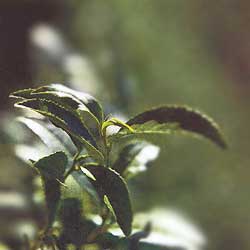 All tea comes from the
leaves of the Camellia Sinensis tree. Tea gardens pluck or prune the
Camellia Sinensis year round and the plant more resembles a bush, but
allowed to grow wild, it reaches heights of about thirty feet.
All tea comes from the
leaves of the Camellia Sinensis tree. Tea gardens pluck or prune the
Camellia Sinensis year round and the plant more resembles a bush, but
allowed to grow wild, it reaches heights of about thirty feet.
Three types of tea are produced from the leaves - green teas,
black teas, and oolong teas. While there are about three thousand
variations of tea, all are derived from the Camellia Sinensis. Some
herbal infusions, such as chamomile, are often referred to incorrectly
as tea. These infusions normally contain leaves, flowers, and other
dried ingredients from other plants.
Green tea, which is
unfermented tea, remains the most popular tea in Asian countries such as
China and Japan. In fact, up until the eighteenth century, it was also
the most popular form of tea in Britain as well. Imports of green tea
into the United States outpaced black tea until about 1915. Much of the
tea dumped into the Boston harbor during the Boston Tea Party, was in
fact green tea. Thus it is unlikely that the harbor turned to a copper
color!
About ninety percent of the world's green tea is produced
in China. While most of the world's black tea comes from countries such
as Sri Lanka (Ceylon), India, Kenya, Indonesia and Argentina, these
countries produce little, if any, green tea. Several hundred varieties
of green tea are made in China alone. Some of the most popular include
Gunpowder, Hyson, Imperial Green, and Gyokuro (Japan). A cup of green
tea is generally much lighter than other teas. While Asian cultures have
believed for centuries that green tea has properties beneficial to human
health, modern science is just now discovering that this may be true.
Manufacture
Differences between green, black, and
oolong teas occur during the processing of the tea leaves.
Plucking
All types are normally hand plucked.
Pluckers take only the bud and two leaves, as only young leaves produce
good quality tea. Machine plucked tea is usually inferior.
Withering
The next step in manufacturing is withering.
Tea leaves are laid out and allowed to wilt for several hours. Leaves
are laid out in bamboo trays or in withering beds indoors. Withering
reduces the moisture content in the leaves and prepares them for the
next step. Withering can be omitted during the production of green tea,
but is crucial in black tea manufacture.
Steaming
This
process differentiates green tea from other types. After withering,
green tea leaves are immediately steamed, baked, or pan heated. This
crucial step in green tea manufacture prevents the oxidation
(fermentation) of the leaves so that they remain green.
Rolling
Green tea is very often hand rolled, but
mechanical rollers are used as well. The rolling process gives the
leaves their appearance. During green tea manufacture, leaves are
usually steamed rolled and steamed alternatively. Tightly rolled leaves
are an indication of good quality tea.
Firing
Green
tea leaves are given a final firing to dry the leaves and ensure no
oxidation of the leaves occurs. The firing of leaves is done in ovens.
Japanese Green Tea production
Japanese green tea production keeps tea
green by steaming tea leaves and parching in order to stop
fermentation.
After that, rough finishing is in the process of rubbing and
drying.
Finishing are in the process of selecting rough finished tea and
drying as well as blending. Hand rubing production method
The purpose
of rubbing tea is to force tea leaves in order that tea leaves organization and
cell membranes are destroyed so that its ingredient will be obtained
easily.
In late 19th century (Meiji period), many hands rubbing tea
production methods are invented.
After that good points of many production
methods were gathered and standardized to a tea production method ( 1953
method). Hence standard hand rubbing tea production method was determined.
Steaming
Tea leaves are steamed in short time and cooled down
rapidly (30seconds to 40 seconds.)
First rubbing
There are 3
process, Hafurui (selection tea leaves), Kaitenntumi (turning rubbing), Tamatoki
( untied tea lumps)
In the process of Hafurui, steamed tea leaves are
sifted out equally and make tea leaves water 80%. (30 minutes to 50
minutes).

In the process of Tamatoki.tea lumps made from rubbing are
untied.
In the process of Kaitentsumi, tea leaves are forced in order
that water in tea leaves evaporated. In the beginning it is called
Keikaiten (light turning).In the end of Kaitentsumi, it is called Jukaiten
(heavy turning).
Waters in tea leaves are reduced to 50% (40minutes to
50 minutes).
In the process of Tamatoki.tea lumps made from rubbing are
untied.

First processing
After Tamatoki is done, tea leaves
are out from tea hearth and cooled down rapidly as well as equalized water in
tea leaves in order to do finishing rubbing easily.

In the process of Dengurimomi, tea leaves are rubbed to shaped
needle like shape. (10 minutes to 20 minutes.)

In the process of Kokuri, tea leaves are shaped further and are
polished to gloss. (10 minutes to 20 minutes).

Drying
Tea leaves are sprinkled and turned over few
times as well as dried. Water of tea leaves reduced until 40% in this process.
(30 minutes to 40 minutes).
There are many hand rubbing production
methods such as Utita-ryu, Ogasamomikiri-ryu, Kouzu-ryu,Kaisin-ryu, Kaitou-ryu,
Kawakami-ryu, Kyoukai ryu, Seito-ryu, Seicho-tyu, Kurakai-ryu,
Tamuta-ryu.
Machine rubing tea production method
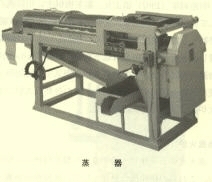
Steaming
machine
Steaming tea leaves is first process of tea production,
therefore, steaming determined tea quality.
This machine steamed in a
short time in order not to make destroyed tea leaves because tea leaves needs to
undestroyed and keeps green by losing oxidization ferment effect in after
rubbing process. (30minutes)
Cooling machine
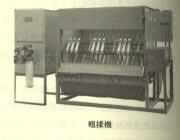 Steamed tea leaves are cooled as well as
eliminate water of tea surface.
Steamed tea leaves are cooled as well as
eliminate water of tea surface.
Rough rubing machine
Rough rubbing
machine rubs tea leaves by heating steamed tea leaves and force in order to make
tea leaves soft as well as reduced water of tea leaves 50%. (45 minutes)
Second rubing machine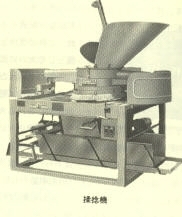
Second rubbing machine gatheres
tea leaves and force gradually and turn in order that tea leaves water equally
spreaded and make tea leaves soft as well as destroyed tea leaves organization.
(20 minutes).
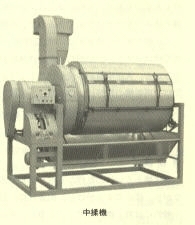 Middle rubing machine
Middle rubing machine
Tea leaves are dried by heat wind
and shaped to twisted and keep water of tea leaves surface as well as evaporate
tea leaves water equally and be in order quality and shape. (40 minutes)
Redrying machine
Tea leaves are dried by heat wind and
shaped.
Final rubing machine
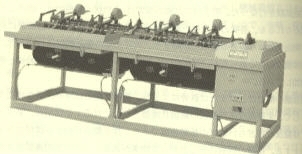
Tea leaves after middle rubbing
machine or redrying machine are heated indirectly and rubbed in order to shaped
to Sencha tea. Waters of tea leaves are reduced to 75%.
(40 minutes)
Drying machine
Water of tea leaves after final rubbing
is 11%-14%, therefore, Water of tea leaves needs to be reduced 4%-5% in order to
preservation. In this process, Tea aroma and taste are created by heating.
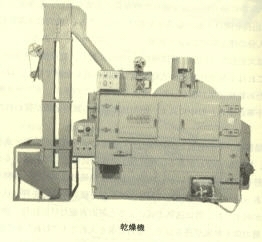
Judgemant of Japanese green tea
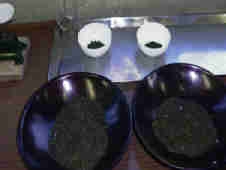 All people engaged in Japanese green tea business judged Japanese green tea by
4 criteria, appearance, aroma, color, taste.
All people engaged in Japanese green tea business judged Japanese green tea by
4 criteria, appearance, aroma, color, taste.
There are two ways of judgment, judgment by sense and scientific judgment by
machine. Usually, we judge Japanese green tea by sense. In judging appearance,
150g of Japanese green teas are put on Judgment tray.
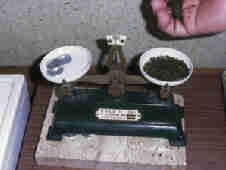
In judging aroma, color, taste, two 3g of Japanese green teas are put each tea
cup of balances.
Aroma judged by scooping tea and be close to nose. Taste is judged by scooping
tea liquid and tasted on tongue and after be out of mouth not drank.
Appearance
Shape and gloss are judged in appearance. Presence or equality of scale, tight
are judged. In judging gloss, nutrition of material tea leaves, production,
plucking time are judged.
Aroma
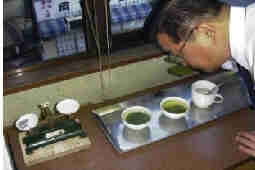
Preferable aroma is refreshed aroma that combined of flowery aroma, fruity
aroma, medical aroma, resinous aroma, and heated aroma.
Preferable Senate tea aromas are refreshed new leaves aroma, light heated
aroma, light flowery aroma.
Color
Color is judged by that tea leaves are eliminated and judged quickly before
temperature will be down. Tea leaves material, handling tea leaves, processing,
changing quality are judged.
Taste
Taste is important quality of Japanese green tea. Taste, refreshes, density,
sweetness, astringent and bitterness are judged.
An overview of the basic processing methods for various green teas
| Tea
Plant |
||||||
|
Cultivation |
Shade Grown | Sun Grown | ||||
| 90%+ Shading for 2 weeks |
40-50% for 1-2 weeks Shading |
Full Sun | ||||
| Harvest Late April to Early May. First harvest is known as "Ichiban-cha" or "Shincha" - The highest quality tea that will be produced in the year. |
Fresh Leaves | Fresh Leaves | ||||
| Enzyme Inactivation |
Steaming | Steaming Steaming at 95-100°C for 30-45 seconds, longer for "Fukamushi" |
||||
|
Processing |
1st Drying |
Drying |
1st Drying | 1st Drying 48 minutes |
||
| Rolling | Rolling | Rolling 24 minutes @ room temperature |
||||
| 2nd Rolling/Drying | 2nd Rolling/Drying | 2nd Rolling/Drying 40 minutes |
||||
| 3rd Rolling/Drying | 3rd Rolling/Drying | Final Rolling/Drying 40 minutes |
||||
| Final Drying | Final Drying | Final Drying 30 minutes, reduction of moisture content to 5% |
||||
|
Refining |
Removal of stems & debris. For matcha, only the inner, fine part of the leaf is used |
|||||
| Grinding | Roasting | |||||
| End Product: | Gyokuro | Matcha | Kabusecha | Sencha | Hojicha | |
Storage - Green tea is more sensitive to deterioration by heat or moisture that other types of teas. For that reason, the moisture content of the teas are reduced to the 2-3% level in the last firing process, and are then packaged in moisture proof containers, with the better teas packaged with the oxygen inside of the bag replaced by nitrogen to protect from oxidation. To keep maximum green tea benefits in place, un-opened product should be stored under refridgeration at 32-41°F (0-5°C) until use.

